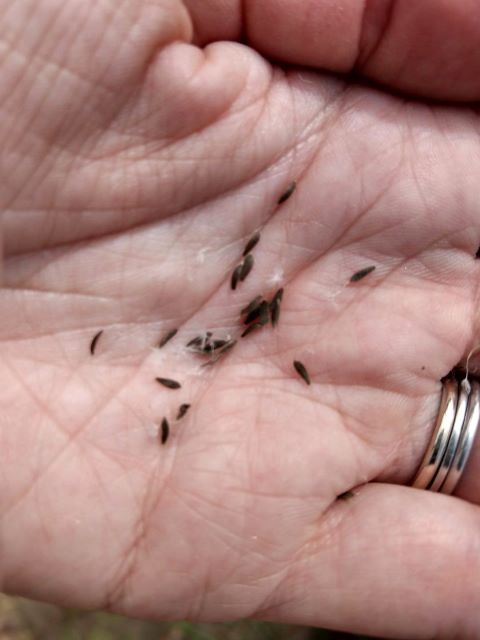Lettuce, the leafy greens, reds, and purples, that fill our salad bowls, are a popular choice for home gardeners across the globe. If like me, you have walked outside to inspect your lettuce and noticed it has started to flower, you may be wondering why and how this happened.

If lettuce plants begin to flower, they have bolted or gone to seed. Lettuce bolts or flowers naturally when it has reached the end of their life cycle. However if lettuce flowers prematurely it is likely due to being stressed by the temperature, the soil pH is incorrect, or if the soil is too dry.
If you notice the main lettuce stem is starting to look taller, and the leaves seem more widely spaced than they once did, your lettuce is about to bolt. Read on to find out why this has happened and how to prevent it.

Related: Lettuce Pests And How to Get Rid of Them | 7 Reasons Your Lettuce Is Dying (And How To Fix It!)
Table of Contents
The Causes and Solutions to Flowering Lettuce
First, it’s important to note that your lettuce will flower, it is inevitable. This is because lettuce is an annual plant and therefore it follows a lifecycle like any other plant. Sometimes, something will happen that will make a lettuce plant react like it has reached the end of its life cycle. When a lettuce plant reaches the end of its lifecycle it goes to seed by producing flowers.
Once a lettuce plant has gone to seed, or bolted, the once tender and juicy leaves become bitter and brittle, definitely not what you want to feed people or eat yourself. Once your lettuce has begun showing signs of bolting it is time to pull up the plant unless you would like the lettuce seeds to plant next year.
Here is a list of reasons why your lettuce could have bolted, and how to fix it.
1. Warmer Weather Has Arrived
One of the most common reasons your lettuce has bolted is that the weather has started to warm up and dry out. Warmer weather brings with it longer days, which triggers your bolting in lettuce. Lettuce prefers shorter, cooler days.
Lettuce is a cooler-weather plant and prefers wetter conditions. Lettuce thrives in temperatures ranging between 60 to 65°F (15-18 °C). When the temperatures start to reach 70-75°F (21-24 °C) your lettuce will bolt.
It’s best to plant lettuce at the very beginning of Spring. Lettuce is a hardy plant that will survive a late frost. If you are worried about a cold snap or frost killing your crop, you can cover it. Another way to protect your lettuce from bolting due to the heat is by providing shade.
You can provide your lettuce plants with shade by erecting shade cloth over them like this one. Shade cloth keeps the light directly off your leafy greens, and keeps the soil from drying out too much. If you don’t want to use shade cloth or can’t, plant your lettuce under a taller plant to offer it natural protection from the sun’s rays.
To prevent your lettuce from bolting when the temperatures start to climb, plant lettuce varieties that are slightly more heat resistant. Starfighter Lettuce, which is a Green Leaf variety, is a hardy, heat-resistant option.
Romaine cultivars such as Sparx and Salvius fare better in warmer weather too. New Red Fire which is a red leaf variety, is another great bolt-resistant option. New Fire Red is particularly hardy and can be grown in warmer weather without becoming bitter.
2. It is Too Cold
In the same way, warmer temperatures can cause your lettuce to go to seed, cooler weather can cause your lettuce to feel threatened and bolt. Your lettuce can indeed withstand colder temperatures and even a light frost. However, prolonged exposure to colder temperatures can cause your lettuce to flower.
If lettuce plants are exposed to temperatures ranging from 40 to 50°F (5-10 °C) for longer than four or five days, flower buds will form from the stress. When the weather starts to heat up, their stalks will shoot up and you will have to pull the plants.
3. Your Soil pH Level is Incorrect
If your lettuce has started to bolt or is fully blooming in your veggie patch during the cooler days of spring, the cause could be the pH level of your soil. If you read that and thought, “my what now?” (we have all been there!), not to worry.
Soil pH levels refer to the amount of alkalinity or acidity present in your soil. The scale ranges from 0 – 14 where 7 would be considered the neutral point. You can purchase a soil testing kit like this one.
The optimum pH level for growing lettuce should range between 6.2 and 6.8. The pH level of your soil varies due to the amount of rainfall in your area. The natural soil pH level in an area that experiences higher levels of rainfall ranges between 5 and 7. Dryer areas usually have a soil pH level of 6.5 to 9.
4. Not Enough Water

Lettuce can start to bolt if it is not getting enough water. Luckily this one is easy to fix! Regular watering of your lettuce plants can help to prevent bolting. You should water your lettuce plants if the soil is dry 1 inch deep. Depending on your region’s rainfall, you will need to water your lettuce twice a week, or every 4 to 5 days.
If your lettuce is planted in pots, it will need to be watered more frequently as the soil will dry out quicker. If you are in an area with water restrictions or do not have the time to monitor your soil, mulching your soil will mean you will not have to water your lettuce plants as much.
You can help to keep the soil around your lettuce plants moist by surrounding them with mulch. Be mindful not to cover the lettuce plants in the mulch. A variety of mulches are available, with dried grass clippings or straw making an excellent choice for mulching your lettuce.
Can You Eat Flowering Lettuce?
While you can eat lettuce that is flowering, it will taste bitter so you probably won’t want to. This is due to a compound known as sesquiterpene lactones being produced by bolting lettuce, giving the leaves their bitter flavor.
Instead, you can either pull up the lettuce plant and plant new ones if have time in the season. Or I prefer to let my lettuce plants flower, which helps bring in beneficial insect into the garden.
Collecting Lettuce Seeds For Planting


Lettuce that bolts can have their seeds collected for planting the next season. Once the lettuce plant and flowers have tried out, you can cover the flowers with a paper bag and shake the flowers into the bag, releasing all the lettuce seeds. Then simply store the lettuce seeds in a dry, cool place, for planting in the following season.
If you want a really easy way to garden, you can let nature do her thing by allowing the wind to spread the lettuce seed around the garden. Then when the conditions are right again, new lettuce seedlings will emerge in your garden on their own.
Related Reading:
